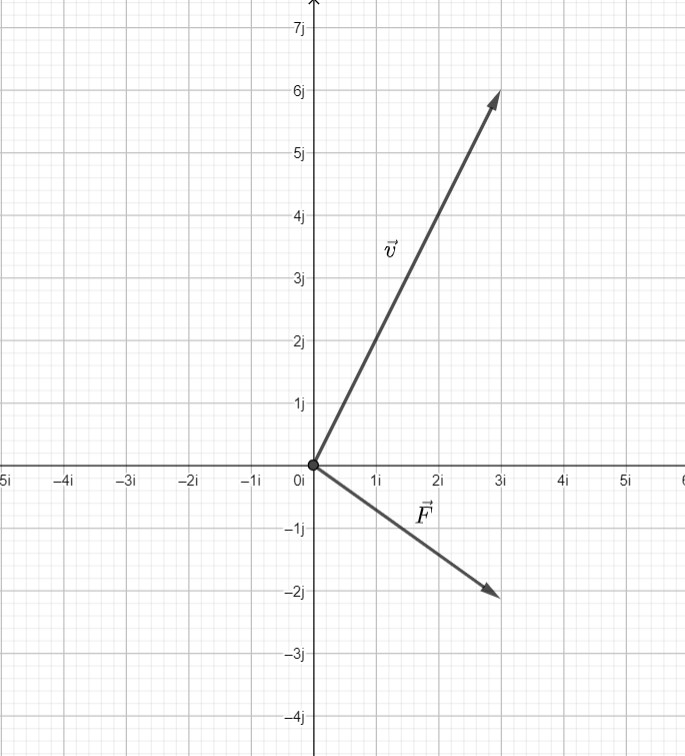The power is the rate of work or rate of energy transfer. The Sl units for power are joule/second also known as a watt. The power provided by a force Facting on a object moving at velocity i is given by dW d P di -(F - AF) = F . = F.5 dt dt dt A force F = (31 – 2j)N acts on a particle traveling with velocity i = (4 î + 6j) m/s. a. What is the power generated by this force? b. Another way to calculate the scalar product is to use the angle between the vectors so P = ||F|| ||| cos o. Based on your result for part (a), what was the angle between F and D?
The power is the rate of work or rate of energy transfer. The Sl units for power are joule/second also known as a watt. The power provided by a force Facting on a object moving at velocity i is given by dW d P di -(F - AF) = F . = F.5 dt dt dt A force F = (31 – 2j)N acts on a particle traveling with velocity i = (4 î + 6j) m/s. a. What is the power generated by this force? b. Another way to calculate the scalar product is to use the angle between the vectors so P = ||F|| ||| cos o. Based on your result for part (a), what was the angle between F and D?
College Physics
11th Edition
ISBN:9781305952300
Author:Raymond A. Serway, Chris Vuille
Publisher:Raymond A. Serway, Chris Vuille
Chapter1: Units, Trigonometry. And Vectors
Section: Chapter Questions
Problem 1CQ: Estimate the order of magnitude of the length, in meters, of each of the following; (a) a mouse, (b)...
Related questions
Question

Transcribed Image Text:(3) The power is the rate of work or rate of energy transfer. The Sl units for power are joule/second also known as a
watt. The power provided by a force Facting on a object moving at velocity i is given by
dW d
P = -
dt dt
di
:(F · AF) = F . = F õ
dt
A force F = (31 – 2j)N acts on a particle traveling with velocity i = (4 î + 6j) m/s.
a. What is the power generated by this force?
b. Another way to calculate the scalar product is to use the angle between the vectors so P = ||F|| |||| cos p.
Based on your result for part (a), what was the angle between F and v?
Expert Solution
Step 1
Given:
The force is equal to:
The velocity is equal to:

Trending now
This is a popular solution!
Step by step
Solved in 2 steps with 1 images

Recommended textbooks for you

College Physics
Physics
ISBN:
9781305952300
Author:
Raymond A. Serway, Chris Vuille
Publisher:
Cengage Learning

University Physics (14th Edition)
Physics
ISBN:
9780133969290
Author:
Hugh D. Young, Roger A. Freedman
Publisher:
PEARSON

Introduction To Quantum Mechanics
Physics
ISBN:
9781107189638
Author:
Griffiths, David J., Schroeter, Darrell F.
Publisher:
Cambridge University Press

College Physics
Physics
ISBN:
9781305952300
Author:
Raymond A. Serway, Chris Vuille
Publisher:
Cengage Learning

University Physics (14th Edition)
Physics
ISBN:
9780133969290
Author:
Hugh D. Young, Roger A. Freedman
Publisher:
PEARSON

Introduction To Quantum Mechanics
Physics
ISBN:
9781107189638
Author:
Griffiths, David J., Schroeter, Darrell F.
Publisher:
Cambridge University Press

Physics for Scientists and Engineers
Physics
ISBN:
9781337553278
Author:
Raymond A. Serway, John W. Jewett
Publisher:
Cengage Learning

Lecture- Tutorials for Introductory Astronomy
Physics
ISBN:
9780321820464
Author:
Edward E. Prather, Tim P. Slater, Jeff P. Adams, Gina Brissenden
Publisher:
Addison-Wesley

College Physics: A Strategic Approach (4th Editio…
Physics
ISBN:
9780134609034
Author:
Randall D. Knight (Professor Emeritus), Brian Jones, Stuart Field
Publisher:
PEARSON